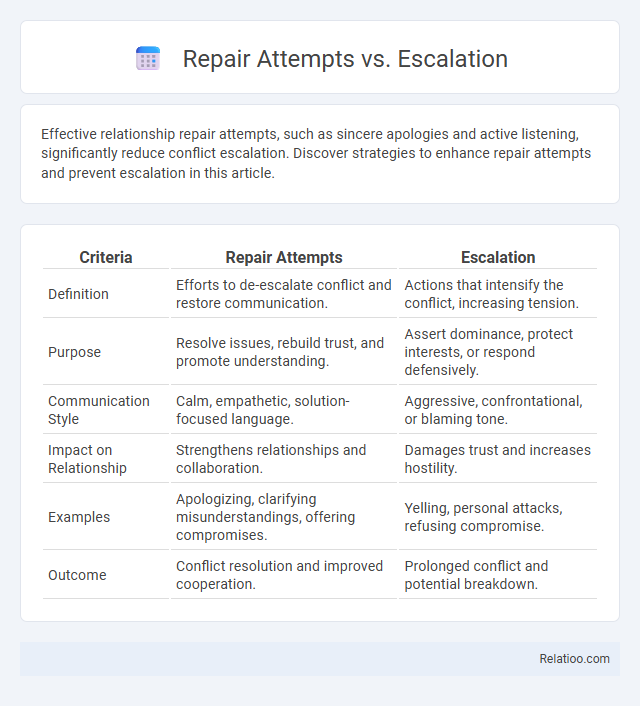Effective relationship repair attempts, such as sincere apologies and active listening, significantly reduce conflict escalation. Discover strategies to enhance repair attempts and prevent escalation in this article.
Table of Comparison
| Criteria | Repair Attempts | Escalation |
|---|---|---|
| Definition | Efforts to de-escalate conflict and restore communication. | Actions that intensify the conflict, increasing tension. |
| Purpose | Resolve issues, rebuild trust, and promote understanding. | Assert dominance, protect interests, or respond defensively. |
| Communication Style | Calm, empathetic, solution-focused language. | Aggressive, confrontational, or blaming tone. |
| Impact on Relationship | Strengthens relationships and collaboration. | Damages trust and increases hostility. |
| Examples | Apologizing, clarifying misunderstandings, offering compromises. | Yelling, personal attacks, refusing compromise. |
| Outcome | Conflict resolution and improved cooperation. | Prolonged conflict and potential breakdown. |
Understanding Repair Attempts in Conflict Resolution
Repair attempts play a crucial role in conflict resolution by signaling a willingness to restore harmony and de-escalate tensions before conflicts intensify. These efforts, such as apologies, clarifications, or humor, can prevent unnecessary escalation to more severe disputes requiring external intervention. Understanding your repair attempts helps improve communication effectiveness and fosters healthier relationship dynamics.
Defining Escalation: When Disagreements Intensify
Repair attempts involve efforts to resolve misunderstandings and maintain connection during conflicts, while escalation occurs when these attempts fail and disagreements intensify, leading to heightened emotional responses. Escalation is defined by a shift from problem-solving to confrontational dynamics where communication becomes more hostile and less constructive. Your ability to recognize signs of escalation early can prevent conflicts from spiraling and promote healthier resolutions.
The Psychology Behind Repair Attempts
Repair attempts stem from an innate psychological drive to restore harmony and resolve conflict, often motivated by a desire to maintain emotional connection and reduce interpersonal tension. Escalation occurs when repair attempts fail or are misunderstood, leading to heightened conflict and defensive behaviors that reinforce negative communication patterns. Effective repair attempts involve empathy, active listening, and timely interventions that prevent escalation by addressing underlying emotional needs and fostering mutual understanding.
Common Triggers of Escalation in Relationships
Repair attempts in relationships often involve direct communication, apologies, or gestures aimed at resolving conflicts before they escalate. Common triggers of escalation include misunderstandings, unaddressed grievances, and emotional misunderstandings that cause emotions to intensify rapidly. Your ability to recognize and respond to these triggers with effective repair attempts can prevent conflicts from escalating into more severe disagreements or breakups.
Key Benefits of Employing Repair Attempts
Employing repair attempts significantly reduces operational downtime by addressing issues at the initial stage, enhancing overall system reliability and user satisfaction. It lowers escalation rates to higher support levels, optimizing resource allocation and reducing cost-intensive interventions. Repair attempts enable faster resolution times and improved first-contact fix rates, leading to more efficient maintenance workflows and prolonged equipment lifespan.
Signs Your Conflict Is Escalating
Repair attempts often involve efforts like open communication and compromise aimed at de-escalating tension, while escalation is marked by intensified negative emotions, increased blame, and breakdown in dialogue. Signs your conflict is escalating include raised voices, persistent criticism, withdrawal, and repeated misunderstandings that hinder resolution. Recognizing these indicators early allows for timely repair attempts to prevent further escalation and promote conflict management.
Effective Strategies for Repair Attempts
Effective strategies for repair attempts prioritize thorough diagnostics and step-by-step troubleshooting to identify and resolve underlying issues before escalation. Implementing standardized repair protocols and leveraging real-time data analytics can enhance accuracy and reduce repeat attempts. Training technicians in advanced problem-solving and communication skills further minimizes unnecessary escalations and improves first-time fix rates.
Consequences of Unchecked Escalation
Unchecked escalation of repair attempts often leads to prolonged downtime, increased operational costs, and reduced system reliability. Each unnecessary escalation amplifies the risk of miscommunication and delays, hindering efficient resolution and causing cascading failures. Effective triage and timely intervention prevent escalations, preserving asset integrity and maintaining optimal performance.
Balancing Repair Attempts and Escalation Management
Balancing repair attempts and escalation management is crucial for optimizing customer support efficiency and satisfaction. Efficient repair attempts minimize unnecessary escalations by resolving issues promptly, while timely escalation ensures complex problems receive expert intervention, reducing overall resolution time. Implementing data-driven thresholds and clear escalation policies harmonizes repair efforts with escalation decisions, improving workflow and resource allocation.
Practical Tips for Shifting from Escalation to Repair
Streamlining repair attempts reduces unnecessary escalations by empowering frontline technicians with targeted training and comprehensive troubleshooting guides. Implementing real-time diagnostic tools and enhancing communication channels fosters timely issue resolution within initial support tiers. Encouraging a culture of continuous learning and leveraging data analytics to identify common failure patterns further shifts focus from escalation to effective repair attempts.

Infographic: Repair attempts vs Escalation
 relatioo.com
relatioo.com